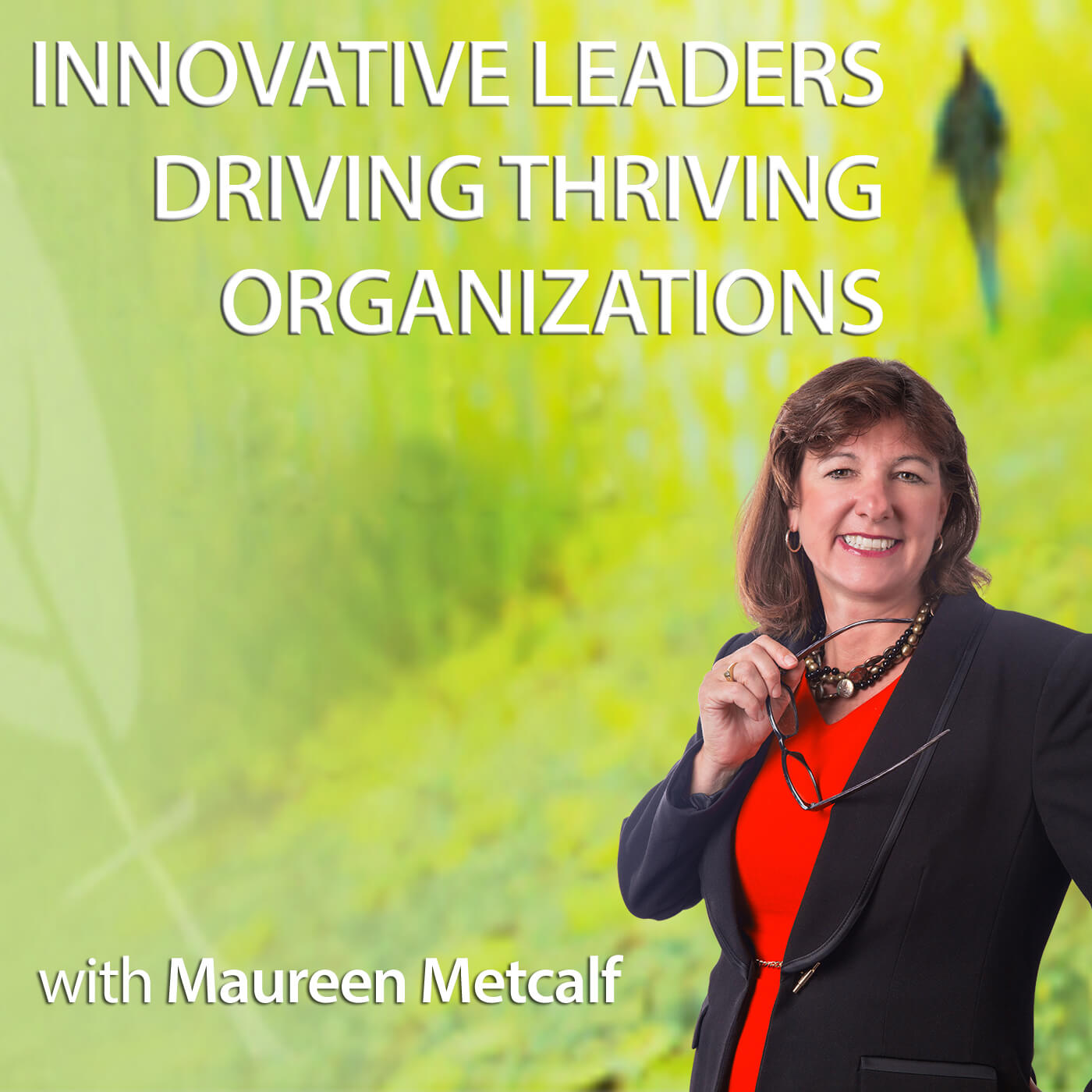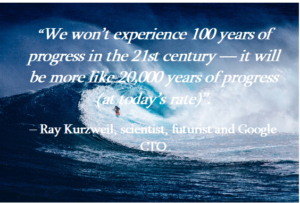This blog was written as a companion to the VoiceAmerica Interview between Mike Sayre and Maureen Metcalf on May 23, 2017, Characteristics of Leadership 2020 – A CEO Perspective. Mike Sayre is the president & COO of Metcalf & Associates, a trusted partner inspiring and enabling perpetual innovation, evolution, and growth in leaders and their businesses. Mike is highly experienced and a successful software, e-commerce, and manufacturing services CEO, COO, CFO, and Board Director. Waves of change in technology are advancing at an exponential rate—20,000 times more than in the last century according to Google CTO and futurist Ray Kurzweil. So are waves of change in society, global and local economics, as well geopolitics. These incredible rates of ongoing change are driving… the evolution of your customers’ needs and your competitors’ offerings faster than ever, the obsolescence of technologies your offerings depend on today, your most capable employees’ desires to leverage new technologies to innovate, grow, and evolve themselves, and a vastly accelerated pace of change in your business. Are you evolving the way you and your team lead to continue to ride these waves of change? If not, you may be swept beneath them. Over the course of human history, there have been six major shifts in societal/cultural norms (eras) with corresponding leadership development and advancement. The first four were driven over tens of thousands of years by increasing populations, the continued need to feed and protect growing population centers, and a primal power base: ARCHAIC: nomadic clans hunting and foraging for food TRIBAL: the formation of tribes and villages and the developments of horticulture and shepherding WARRIOR: the building of city-state empires using serf or slave labor to establish early agricultural practices TRADITIONAL: the growth of city-state empires to wide-spread kingdoms and monarchies battling over turf and power Next came the MODERN Industrial Scientific era where leadership spent more time and energy on perfecting tasks and processes (think assembly lines) to support mass production and distribution of traditional products, but also products based on new technologies, like automobiles, mostly in developing nation-states with access to the required resources. Commercial success translated into new power bases. The Modern era developed over a period of approximately two-hundred years and many people and organizations are still functioning at this level. Then came the POST-MODERN era where leadership became much more introspective, thoughtful, and systems oriented, where the information age and the internet have spanned virtual transnational networks. This era has really only developed over the last 20-30 years with the advent of the internet. Note that the first four eras developed over tens of thousands of years and that some parts of the third-world still may be functioning at some combination of the Tribal, Warrior and Traditional eras. They co-exist in close proximity to parts of the world where the Modern and Post-Modern eras developed over just the last couple of hundred years. Hence, it is reasonable to assume that the incredible rate of increasing technological advancement over time so far will only continue to increase exponentially going forward, and Kurzweil’s predictions are not so far-fetched as they may seem! It has become more and more difficult for leaders and organizations to keep up. So now, we are beginning to experience the seventh societal/cultural/leadership shift into what we call the INTEGRAL era. In this era, technological change, economic change and geopolitical change outpace the abilities of most Modern and Post-Modern leaders who think in terms of tasks, processes, and systems. Integral era leadership must consider the constant evolution of entire ecosystems in which we operate, and evolve ahead of the curve—or at least with the curve—to just survive, let alone thrive. When today’s foremost leadership experts were doing research for the book Leadership 2050, they looked at five recent global studies on organizational leadership needs for the future. All five studies generally concluded that there are not enough leaders in our current leadership pipeline that have the higher-ordered skills and capacities to meet the complexity of today’s challenges, not to mention those needed for 2050. What are those higher-ordered skills? 1. Being professionally humble – Astute leaders care more about doing the right thing than being right. Their focus is on the mission and they consistently give credit to their team and others when they succeed. 2. Having an unwavering commitment to right action – A thoughtful leader consistently makes decisions based on what action will most effectively advance the organization’s mission, even if doing it is not the easiest path. 3. Being a 360-degree thinker – A prudent leader consistently considers the industry, environment and trends driving future success, in addition to the organizations’ strategies, capabilities, and, most obvious, environmental factors. 4. Being intellectually versatile – Creative leaders draw from a broad set of interests and involvement in activities outside their organization. Those activities also give them opportunities to recharge. 5. Being highly authentic and reflective – Self-aware leaders who possess a strong sense of mission and are transparently guided by a set of consistently adhered-to principles build trust that promotes an environment of high performance. 6. Inspire followership – Leaders strong in the previous competencies, with a sense of humor and mild self-deprecation, who are warm and empathetic, inspire a followership that appreciates the tough conversations required to maintain ever-higher performance and achievement, and are continually inspired to do more. 7. Being innately collaborative – Exceptional leaders value input from experts and those impacted by key decisions, and promote the offering of differing points of view, knowing that multiple perspectives result in better outcomes, more support, and stronger execution. How can you develop these higher-ordered skills? These competencies generally take years to develop and are gained through both unplanned and planned life and career experiences. Nick Petrie from the Center of Creative Leadership says what he calls “vertical ego-maturity development” is helping leaders move from one level of ego-maturity to the next (becoming less self-centered) to match leadership style with the demands of society. A similar leadership developmental process occurred to move between each of the societal levels referenced above, with the specifics varying according to life conditions. This transformation process occurs through: Heat Experiences where a leader faces a complex situation that disrupts and disorients a habitual way of thinking. Through this experience there is a recognition that the current way of making sense of the world is inadequate. The leader opens up to different perspectives and starts searching for new and better ways to make sense of the situation. Colliding Perspectives where a leader is exposed to people with different world views, opinions, backgrounds, and training that challenges existing mental models and increases the number of perspectives through which the world is viewed. Elevated Sense-making where a leader uses a coach, or a self-developed process, to help integrate and make sense of these perspectives and experiences from more elevated stages of development. A larger more advanced worldview emerges and, with time, stabilizes. At Metcalf & Associates, we work with our clients to create perpetual innovation, evolution, and growth in their leadership and business by providing Individual or group Innovative Leadership training Team/organization innovative culture development Organizational transformation engagement, and Ongoing consulting, coaching and/or follow-up sessions to ensure: Growth in perspectives when unplanned heat experiences or colliding perspectives “barge in,” Development of elevated sense-making with new perspectives, and Sustainability of developmental goal achievement and/or transformation. Thanks for following us! Please look for more upcoming blogs and blog series at “C” level from Mike.
At C-Level #9: Evolving Leadership for an Evolving World By Maureen Metcalf






